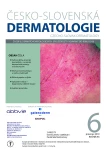Spitz Tumors – Diagnostically Difficult Situations. A Series of Cases
Authors:
T. Fikrle; B. Divišová; J. Šuchmannová; K. Pizinger
Authors‘ workplace:
Dermatovenerologická klinika LF UK a FN Plzeň, přednosta prof. MUDr. Karel Pizinger, CSc.
Published in:
Čes-slov Derm, 94, 2019, No. 6, p. 242-248
Category:
Dermatoscopy
Overview
Spitzoid lesions represent a special group of melanocytic lesions that are usually difficult to diagnose. The terminology has been going through changes for decades and is still not quite completed. Reed and Spitz nevi are considered to be benign and are typical for children and adolescents. Some of the malignant melanomas have “spitzoid features” and mimic both of these nevi groups. Spitzoid lesions that cannot be reliably histologically categorized are usually diagnosed as atypical Spitz tumors. Dermoscopy plays an important role in the diagnostics. Dermoscopic images of Reed and Spitz nevi are well documented. Dermoscopic examination helps in the diagnostics of melanomas with spitzoid features and on the contrary, it enables follow-up without the need of excision in children with Reed nevus. Surgical excisions should be indicated in all Spitzoid lesions with asymmetric dermoscopic images, dermoscopic features of melanoma and in children older than 12 years.
Keywords:
dermoscopy – Reed nevus – Spitz nevus – malignant melanoma – atypical spitzoid tumor
Sources
1. BARNHILL, R. L. The Spitzoid lesion: rethinking Spitz tumors, atypical variants, ‘Spitzoid melanoma’ and risk assessment. Mod Pathol., 2006, 19, p. 21–33.
2. DIKA, E., RAVAIOLI, G. M., FANTI, P. A. et al. Spitz Nevi and Other Spitzoid Neoplasms in Children: Overview of Incidence Data and Diagnostic Criteria. Pediatr Dermatol., 2017, 34(1), p. 25–32.
3. HALIASOS, E. C., KERNER, M., JAIMES, N. et al. Dermoscopy for the pediatric dermatologist part III: dermoscopy of melanocytic lesions. Pediatr Dermatol., 2013, 30(3), p. 281–293.
4. LALLAS, A., APALLA, Z., IOANNIDES, D. et al. Update on dermoscopy of Spitz/Reed naevi and management guidelines by the International Dermoscopy Society. Br J Dermatol., 2017, 177(3), p. 645–655.
5. LALLAS, A., APALLA, Z., PAPAGEORGIOU, C. et al. Management of Flat Pigmented Spitz and Reed Nevi in Children. JAMA Dermatol., 2018, 154(11), p. 1353–1354.
6. LALLLAS, A., MOSCARELLA, E., LONGO, C. et al. Likelihood of finding melanoma when removing a Spitzoid-looking lesion in patients aged 12 years or older. J Am Acad Dermatol., 2015, 72(1), p. 47–53.
7. MONES, J. M., ACKERMAN, A. B. “Atypical” Spitz’s nevus, “malignant” Spitz’s nevus, and “metastasizing” Spitz’s nevus: a critique in historical perspective of three concepts flawed fatally. Am J Dermatopathol., 2004, 26, p. 310–333.
8. MOSCARELLA, E., LALLAS, A, KYRGIDIS, A. et al. Clinical and dermoscopic features of atypical Spitz tumors: A multicenter, retrospective, case-control study. J Am Acad Dermatol., 2015, 73(5), p. 777–784.
9. PAPAGEORGIU, V., APALLA, Z., SORTIRIOU, E. et al. The limitations of dermoscopy: false-positive and false-negative tumours. J Eur Acad Dermatol Venereol., 2018, 32(6), p. 879–888.
10. REED, R. J., ICHINOSE, H., CLARK, W. H. et al. Common and uncommon melanocytic nevi and borderline melanomas. Semin Oncol., 1975, 2, p. 119–147.
11. SMITH, K. J., BARRETT, T. L., SKELTON, H. G. 3rd et al. Spindle cell and epithelioid cell nevi with atypia and metastasis (malignant Spitz nevus). Am J Surg Pathol., 1989, 13, p. 931–939.
12. SPITZ S. Melanomas of childhood. Am J Pathol., 1948, 24, p. 591–609.
Labels
Dermatology & STDs Paediatric dermatology & STDsArticle was published in
Czech-Slovak Dermatology

2019 Issue 6
Most read in this issue
- Svědění konečníku
- Spitz Tumors – Diagnostically Difficult Situations. A Series of Cases
- Systemic Treatment of Atopic Dermatitis – European Guidelines and Current State of Art
- Clinical Case: Pink Papule on the Calf
